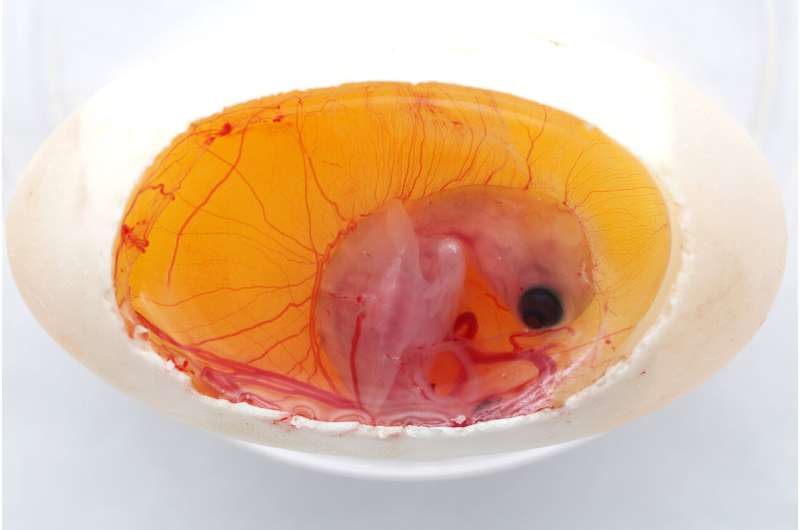A turtle embryo. Credit: Ye et. al / Current Biology
In certain turtle species, the temperature of the egg determines whether the offspring is female or male. But now, new research shows that the embryos have some say in their own sexual destiny: they can move around inside the egg to find different temperatures. The study, publishing August 1 in the journal Current Biology, examines how this behavior may help turtles offset the effects of climate change.
"We previously demonstrated that reptile embryos could move around within their egg for thermoregulation, so we were curious about whether this could affect their sex determination," says corresponding author Wei-Guo Du, professor at the Chinese Academy of Sciences. "We wanted to know if and how this behavior could help buffer the impact of global warming on offspring sex ratios in these species."
Du and his colleagues incubated turtle eggs under a range of temperatures both in the laboratory and in outdoor ponds. They found that a single embryo could experience a temperature gradient of up of 4.7°C within its egg. This is significant because any shift larger than 2°C can massively change the offspring sex ratio of many turtle species, Du said.
In half of the eggs, they applied capsazepine, a chemical that blocked temperature sensors, to prevent behavioral thermoregulation. After the eggs hatched, the researchers found that the embryos without behavioral thermoregulation had developed as either almost all males or almost all females, depending on the incubation temperatures. In contrast, embryos that were able to react to nest temperatures moved around inside their eggs; about half of them developed as males and the other half as females.
"The most exciting thing is that a tiny embryo can influence its own sex by moving within the egg," Du says.
By moving around the egg to find what Richard Shine, a professor at Macquarie University of Australia and one of the co-authors, calls the "Goldilocks Zone"—where the temperature is not too hot and not too cold—the turtles can shield against extreme thermal conditions imposed by changing temperatures and produce a relatively balanced sex ratio. "This could explain how reptile species with temperature-dependent sex determination have managed to survive previous periods in Earth history when temperatures were far hotter than at present," he says.
But this behavior has limitations, Du says, depending on the conditions of the egg and the embryo itself. "Embryonic thermoregulation can be limited if the thermal gradient within an egg is too small, or if the embryo is too large to move around or too young to have developed these abilities yet," he says.
Additionally, the behavior cannot buffer the impact of episodes of extremely high temperatures, which are predicted to increase with climate change, Du says.
"The embryo's control over its own sex may not be enough to protect it from the much more rapid climate change currently being caused by human activities, which is predicted to cause severe female-biased populations," he says. "However, the discovery of this surprising level of control in such a tiny organism suggests that in at least some cases, evolution has conferred an ability to deal with such challenges."
Du says that this study indicates that these species may have some ways not yet discovered to buffer this risk. "Our future studies will explore the adaptive significance of embryonic thermoregulation as well as the other behavioral and physiological strategies adopted by embryos and mothers to buffer the impact of climate warming on turtles."
More information: Current Biology, Ye et al.: "The Embryos of Turtles Can Influence Their Own Sexual Destinies" www.cell.com/current-biology/f … 0960-9822(19)30765-1 , DOI: 10.1016/j.cub.2019.06.038
Journal information: Current Biology
Provided by Cell Press
























